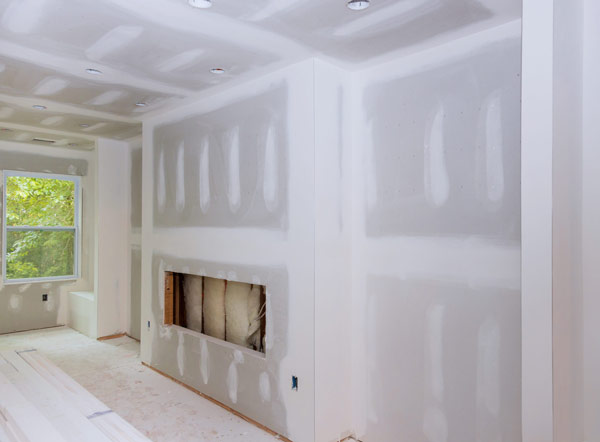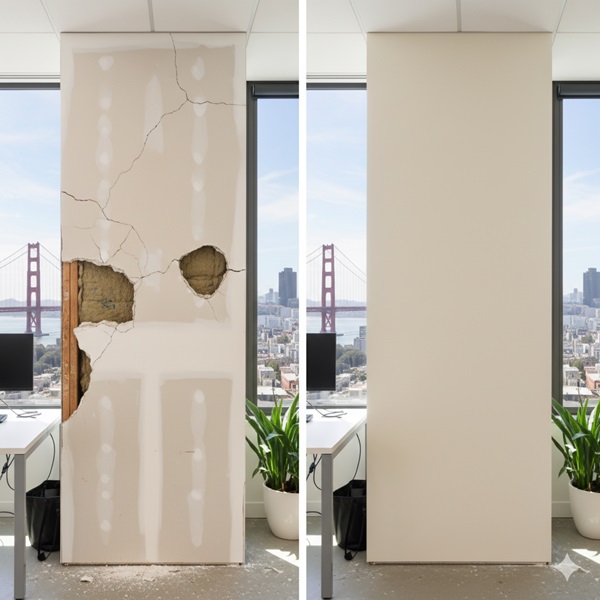Step-by-Step Approaches to Achieving Flawless Drywall Repair Work and Setup
Attaining remarkable drywall fixing and installation needs an organized approach. It includes comprehending the different types of drywall and the tools needed for the job. Proper area preparation is crucial prior to beginning any kind of job. drywall contractor. Each step, from patching holes to setting up new sheets, demands attention to information. The procedure does not finish with setup; ending up strategies are critical for a polished look. The next steps will ensure a smooth outcome, yet just what do they entail?
Recognizing Drywall Kind and Tools Needed

The installment tools are equally crucial. An energy knife is essential for cutting drywall sheets, while a drywall saw can aid in making precise cuts for outlets or components. T-squares assure exact dimensions, and drywall screws or nails secure the panels to wall surface studs. Furthermore, a drywall lift can help with the installation of large sheets, decreasing physical stress. Experience with these devices and types substantially adds to the effectiveness and high quality of drywall jobs.
Preparing the Location for Fixing or Setup
Preparing the area for drywall repair service or installation is crucial to ensure a efficient and smooth procedure. First, the surrounding area must be removed of furnishings and other obstacles to provide sufficient functioning room. This not just assures security yet also prevents damages to items. Next, it is important to cover the floor with ground cloth to catch any debris or dust produced during the work.
Furthermore, the walls should be inspected for any loose paint or wallpaper that may disrupt bond. Getting rid of these components develops a clean surface area for the brand-new drywall. Prior to start, it is advisable to switch off power to electric outlets or components in the vicinity. Making sure ample lights in the office will certainly even more boost presence and emphasis during the repair service or installment procedure. Interior Painting. By carefully preparing the area, one prepares for a successful drywall task
Step-by-Step Process for Patching Holes

Covering openings in drywall needs a systematic technique to assure a seamless repair. The very first step involves examining the dimension of the hole. For small holes, a patching compound might suffice, while larger holes require a spot. Next, the damaged area ought to be cleansed and prepared by getting rid of any type of loose debris.
For little holes, applying spackling substance with a putty blade is check my site advised, smoothing it over the hole and feathering the sides. As soon as dry, fining sand the location guarantees a smooth finish. For larger holes, a drywall spot should be cut to dimension, placed over the hole, and secured with screws. After mounting the patch, the exact same spackling process is duplicated, adhered to by sanding.
The patched location has to be primed and repainted to match the bordering wall. This precise procedure assures a professional appearance and prolongs the life-span of the repair work.
Installing New Drywall Sheets: A Comprehensive Guide
Installing new drywall sheets needs careful planning and implementation to ensure a visually appealing and sturdy coating. The location must be determined accurately to figure out the number of sheets needed. It is crucial to choose the ideal thickness, typically 1/2-inch for indoor walls and 5/8-inch for ceilings or fire-rated applications.
Next, the studs or framework need to be inspected for any abnormalities, ensuring they are aligned and correctly spaced. When putting the drywall sheets, they must be placed horizontally to reduce seams and boost architectural integrity. A drywall lift can be valuable for overhead setups.
Fastening the sheets with drywall screws at proper periods ensures a protected setup. It is very important to countersink the screws somewhat listed below the surface area to get ready for the completing process. Following these standards this will certainly bring about a strong structure, all set for the following actions in drywall ending up.
Finishing Touches: Taping, Mudding, and Sanding Techniques
Once the drywall sheets are securely fastened, the focus shifts to the finishing touches that will certainly provide a polished look. This procedure starts with taping, making use of either paper or fiberglass fit together tape to cover the seams between sheets. The tape guarantees a smooth shift, decreasing the risk of breaking. Complying with taping, mudding is important; a joint compound is used over the tape to load spaces and produce a seamless surface area. Commonly, numerous layers are required, each one feathery out additionally than the previous to reduce visibility.
After enough drying out time, sanding is the final action in attaining a perfect surface. A fine-grit sandpaper is used to smooth the dried out substance, ensuring there are no bumps or imperfections. Focus to detail during this phase is substantial, as it substantially influences the overall look of the wall. Completion result must be an even, professional-looking surface area all set for priming and painting.
Frequently Asked Concerns
Just how Do I Pick the Right Drywall Thickness for My Job?
To choose the ideal drywall thickness, consider the task's function, place, and structural demands. Standard densities include 1/2-inch for basic usage and 5/8-inch for fire-rated applications, ensuring resilience and conformity with building ordinance.

Can I Install Drywall Over Existing Drywall?
Yes, installing drywall over existing drywall is possible. However, it is vital to assure the underlying surface area is free and safe and secure from damages. Correct attachment and consideration of density are essential for an effective installment.
What Are the very best Practices for Drywall Disposal?
The most effective methods for drywall disposal consist of recycling when possible, using regional waste administration services, and following standards for unsafe go to these guys products if suitable. drywall contractors. Correctly sealing and classifying waste guarantees conformity and safety and security during disposal
How much time Should I Await Mud to Dry Before Sanding?
Typically, one need to wait 1 day for drywall mud to dry before fining sand. Drying time can differ based on humidity and temperature level, so inspecting for a firm appearance is recommended before continuing.
Exist Eco-Friendly Drywall Options Available?
Yes, eco-friendly drywall choices are readily available. These alternatives usually use recycled products, low-VOC adhesives, and sustainable manufacturing methods, minimizing environmental effect while giving efficient insulation and resilience for numerous building and improvement tasks.
An energy knife is crucial for cutting drywall sheets, while a drywall saw can assist in making exact cuts for electrical outlets or fixtures. Preparing the location for drywall repair or installation is crucial to guarantee a smooth and effective procedure. Patching openings in drywall requires an organized method to guarantee a smooth repair. Mounting new drywall sheets requires mindful planning and execution to ensure a aesthetically attractive and strong finish. Yes, setting up drywall over existing drywall is feasible.